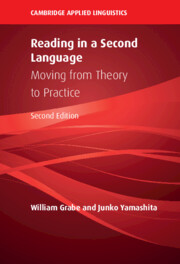Book contents
- Reading in a Second Language
- The Cambridge Applied Linguistics Series
- Reading in a Second Language
- Copyright page
- Dedication
- Contents
- Figures
- Tables
- Preface
- Part I Foundations of Reading
- Part II Patterns of Variation in Reading
- 7 Reading in Different Languages
- 8 L1 and L2 Reading Relationships
- 9 Social Contexts of Reading
- 10 Motivation for Reading
- Part III Developing Reading Comprehension Abilities
- Part IV Expanding Reading Comprehension Skills
- Part V Applications of Reading Research: Instruction and Assessment
- References
- Author Index
- Subject Index
7 - Reading in Different Languages
from Part II - Patterns of Variation in Reading
Published online by Cambridge University Press: 01 September 2022
- Reading in a Second Language
- The Cambridge Applied Linguistics Series
- Reading in a Second Language
- Copyright page
- Dedication
- Contents
- Figures
- Tables
- Preface
- Part I Foundations of Reading
- Part II Patterns of Variation in Reading
- 7 Reading in Different Languages
- 8 L1 and L2 Reading Relationships
- 9 Social Contexts of Reading
- 10 Motivation for Reading
- Part III Developing Reading Comprehension Abilities
- Part IV Expanding Reading Comprehension Skills
- Part V Applications of Reading Research: Instruction and Assessment
- References
- Author Index
- Subject Index
Summary
Chapter 7: Reading Different Languages. This chapter outlines differences in learning to read in differing L1s. Linguistic differences, or linguistic distance, between any given L1 and L2 will be a factor to consider in L2 reading development. The study of linguistic differences when reading across languages also leads to identifying universal linguistic aspects of reading development. The chapter focuses more specifically on differing orthographic systems, from alphabetic systems to morpho-syllabic systems as well as mixed systems. A major source of variation within alphabetic systems is the concept of orthographic depth between orthography and phonology. English is the most opaque orthographic language and, in that respect, is an outlier among languages of the world. Other factors in word recognition development include the informational density of a given orthography, word reading time, and morphological processing. The many differences across languages also impact L1 to L2 reading transfer. The chapter closes with a discussion of reading universals in relation to L1 to L2 reading transfer and provides a set of implications for instruction.
Keywords
- Type
- Chapter
- Information
- Reading in a Second LanguageMoving from Theory to Practice, pp. 147 - 167Publisher: Cambridge University PressPrint publication year: 2022

